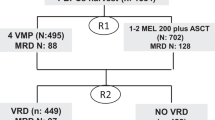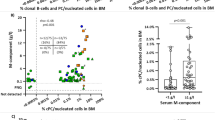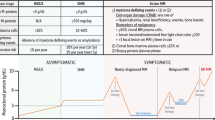Abstract
Achieving complete remission (CR) in multiple myeloma (MM) translates into extended survival, but two subgroups of patients fall outside this paradigm: cases with unsustained CR, and patients that do not achieve CR but return into a monoclonal gammopathy of undetermined significance (MGUS)-like status with long-term survival. Here, we describe a novel automated flow cytometric classification focused on the analysis of the plasma-cell compartment to identify among newly diagnosed symptomatic MM patients (N=698) cases with a baseline MGUS-like profile, by comparing them to MGUS (N=497) patients and validating the classification model in 114 smoldering MM patients. Overall, 59 symptomatic MM patients (8%) showed an MGUS-like profile. Despite achieving similar CR rates after high-dose therapy/autologous stem cell transplantation vs other MM patients, MGUS-like cases had unprecedented longer time-to-progression (TTP) and overall survival (OS; ∼60% at 10 years; P<0.001). Importantly, MGUS-like MM patients failing to achieve CR showed similar TTP (P=0.81) and OS (P=0.24) vs cases attaining CR. This automated classification also identified MGUS patients with shorter TTP (P=0.001, hazard ratio: 5.53) and ultra-high-risk smoldering MM (median TTP, 15 months). In summary, we have developed a biomarker that identifies a subset of symptomatic MM patients with an occult MGUS-like signature and an excellent outcome, independently of the depth of response.
This is a preview of subscription content, access via your institution
Access options
Subscribe to this journal
Receive 12 print issues and online access
$259.00 per year
only $21.58 per issue
Buy this article
- Purchase on Springer Link
- Instant access to full article PDF
Prices may be subject to local taxes which are calculated during checkout





Similar content being viewed by others
Change history
09 October 2013
This article has been corrected since Advance Online Publication and a corrigendum is also printed in this issue
References
San-Miguel JF, Mateos MV . Can multiple myeloma become a curable disease? Haematologica 2011; 96: 1246–1248.
Stewart AK, Richardson PG, San-Miguel JF . How I treat multiple myeloma in younger patients. Blood 2009; 114: 5436–5443.
Leleu X, Fouquet G, Hebraud B, Roussel M, Caillot D, Chretien ML et al. Consolidation with VTd significantly improves the complete remission rate and time to progression following VTd induction and single autologous stem cell transplantation in multiple myeloma. Leukemia 2013; e-pub ahead of print 6 April 2013.
Usmani SZ, Crowley J, Hoering A, Mitchell A, Waheed S, Nair B et al. Improvement in long-term outcomes with successive Total Therapy trials for multiple myeloma: are patients now being cured? Leukemia 2013; 27: 226–232.
Palumbo A, Anderson K . Multiple myeloma. New Engl J Med 2011; 364: 1046–1060.
Palumbo A, Cavallo F . Have drug combinations supplanted stem cell transplantation in myeloma? Blood 2012; 120: 4692–4698.
San-Miguel JF . Consolidation therapy in myeloma: a consolidated approach? Blood 2012; 120: 2–3.
Rajkumar SV . Multiple myeloma: 2012 update on diagnosis, risk-stratification, and management. Am J Hematol 2012; 87: 78–88.
Badros AZ . Lenalidomide in myeloma--a high-maintenance friend. New Engl J Med 2012; 366: 1836–1838.
Chanan-Khan AA, Giralt S . Importance of achieving a complete response in multiple myeloma, and the impact of novel agents. J Clin Oncol 2010; 28: 2612–2624.
Harousseau JL, Attal M, Avet-Loiseau H . The role of complete response in multiple myeloma. Blood 2009; 114: 3139–3146.
Barlogie B, Anaissie E, Haessler J, van Rhee F, Pineda-Roman M, Hollmig K et al. Complete remission sustained 3 years from treatment initiation is a powerful surrogate for extended survival in multiple myeloma. Cancer 2008; 113: 355–359.
Paiva B, Gutierrez NC, Rosinol L, Vidriales MB, Montalban MA, Martinez-Lopez J et al. High-risk cytogenetics and persistent minimal residual disease by multiparameter flow cytometry predict unsustained complete response after autologous stem cell transplantation in multiple myeloma. Blood 2012; 119: 687–691.
Zhan F, Barlogie B, Arzoumanian V, Huang Y, Williams DR, Hollmig K et al. Gene-expression signature of benign monoclonal gammopathy evident in multiple myeloma is linked to good prognosis. Blood 2007; 109: 1692–1700.
Lahuerta JJ, Mateos MV, Martinez-Lopez J, Rosinol L, Sureda A, de la Rubia J et al. Influence of pre- and post-transplantation responses on outcome of patients with multiple myeloma: sequential improvement of response and achievement of complete response are associated with longer survival. J Clin Oncol 2008; 26: 5775–5782.
Rosinol L, Oriol A, Teruel AI, Hernandez D, Lopez-Jimenez J, de la Rubia J et al. Superiority of bortezomib, thalidomide, and dexamethasone (VTD) as induction pretransplantation therapy in multiple myeloma: a randomized phase 3 PETHEMA/GEM study. Blood 2012; 120: 1589–1596.
Durie BG, Harousseau JL, Miguel JS, Blade J, Barlogie B, Anderson K et al. International uniform response criteria for multiple myeloma. Leukemia 2006; 20: 1467–1473.
Paiva B, Almeida J, Perez-Andres M, Mateo G, Lopez A, Rasillo A et al. Utility of flow cytometry immunophenotyping in multiple myeloma and other clonal plasma cell-related disorders. Cytometry B Clin Cytom 2010; 78: 239–252.
Kalina T, Flores-Montero J, van der Velden VH, Martin-Ayuso M, Bottcher S, Ritgen M et al. EuroFlow standardization of flow cytometer instrument settings and immunophenotyping protocols. Leukemia 2012; 26: 1986–2010.
Costa ES, Pedreira CE, Barrena S, Lecrevisse Q, Flores J, Quijano S et al. Automated pattern-guided principal component analysis vs expert-based immunophenotypic classification of B-cell chronic lymphoproliferative disorders: a step forward in the standardization of clinical immunophenotyping. Leukemia 2010; 24: 1927–1933.
Morgan GJ, Walker BA, Davies FE . The genetic architecture of multiple myeloma. Nat Rev Cancer 2012; 12: 335–348.
Kuehl WM, Bergsagel PL . Molecular pathogenesis of multiple myeloma and its premalignant precursor. J Clin Invest 2012; 122: 3456–3463.
Weston-Bell N, Gibson J, John M, Ennis S, Pfeifer S, Cezard T et al. Exome sequencing in tracking clonal evolution in multiple myeloma following therapy. Leukemia 2012; 27: 1188–1191.
Egan JB, Shi CX, Tembe W, Christoforides A, Kurdoglu A, Sinari S et al. Whole-genome sequencing of multiple myeloma from diagnosis to plasma cell leukemia reveals genomic initiating events, evolution, and clonal tides. Blood 2012; 120: 1060–1066.
Keats JJ, Chesi M, Egan JB, Garbitt VM, Palmer SE, Braggio E et al. Clonal competition with alternating dominance in multiple myeloma. Blood 2012; 120: 1067–1076.
Dimopoulos M, Kyle R, Fermand JP, Rajkumar SV, San Miguel J, Chanan-Khan A et al. Consensus recommendations for standard investigative workup: report of the International Myeloma Workshop Consensus Panel 3. Blood 2011; 117: 4701–4705.
Bergsagel PL, Mateos MV, Gutierrez NC, Rajkumar SV, San Miguel JF . Improving overall survival and overcoming adverse prognosis in the treatment of cytogenetically high-risk multiple myeloma. Blood 2013; 121: 884–892.
Avet-Loiseau H, Durie BG, Cavo M, Attal M, Gutierrez N, Haessler J et al. Combining fluorescent in situ hybridization data with ISS staging improves risk assessment in myeloma: an International Myeloma Working Group collaborative project. Leukemia 2013; 27: 711–717.
Barlogie B, Attal M, Crowley J, van Rhee F, Szymonifka J, Moreau P et al. Long-term follow-up of autotransplantation trials for multiple myeloma: update of protocols conducted by the intergroupe francophone du myelome, southwest oncology group, and university of arkansas for medical sciences. J Clin Oncol 2010; 28: 1209–1214.
Mehta J, Singhal S . High-dose chemotherapy and autologous hematopoietic stem cell transplantation in myeloma patients under the age of 65 years. Bone Marrow Transplant 2007; 40: 1101–1114.
Martinez-Lopez J, Blade J, Mateos MV, Grande C, Alegre A, Garcia-Larana J et al. Long-term prognostic significance of response in multiple myeloma after stem cell transplantation. Blood 2011; 118: 529–534.
Kyle RA, Therneau TM, Rajkumar SV, Offord JR, Larson DR, Plevak MF et al. A long-term study of prognosis in monoclonal gammopathy of undetermined significance. New Engl J Med 2002; 346: 564–569.
Kyle RA, Remstein ED, Therneau TM, Dispenzieri A, Kurtin PJ, Hodnefield JM et al. Clinical course and prognosis of smoldering (asymptomatic) multiple myeloma. New Engl J Med 2007; 356: 2582–2590.
Cesana C, Klersy C, Barbarano L, Nosari AM, Crugnola M, Pungolino E et al. Prognostic factors for malignant transformation in monoclonal gammopathy of undetermined significance and smoldering multiple myeloma. J Clin Oncol 2002; 20: 1625–1634.
Hillengass J, Fechtner K, Weber MA, Bauerle T, Ayyaz S, Heiss C et al. Prognostic significance of focal lesions in whole-body magnetic resonance imaging in patients with asymptomatic multiple myeloma. J Clin Oncol 2010; 28: 1606–1610.
Kastritis E, Terpos E, Moulopoulos L, Spyropoulou-Vlachou M, Kanellias N, Eleftherakis-Papaiakovou E et al. Extensive bone marrow infiltration and abnormal free light chain ratio identifies patients with asymptomatic myeloma at high risk for progression to symptomatic disease. Leukemia 2013; 27: 947–953.
Larsen JT, Kumar SK, Dispenzieri A, Kyle RA, Katzmann JA, Rajkumar SV . Serum free light chain ratio as a biomarker for high-risk smoldering multiple myeloma. Leukemia 2013; 27: 941–946.
Bianchi G, Kyle RA, Larson DR, Witzig TE, Kumar S, Dispenzieri A et al. High levels of peripheral blood circulating plasma cells as a specific risk factor for progression of smoldering multiple myeloma. Leukemia 2013; 27: 680–685.
Dispenzieri A, Kyle RA, Katzmann JA, Therneau TM, Larson D, Benson J et al. Immunoglobulin free light chain ratio is an independent risk factor for progression of smoldering (asymptomatic) multiple myeloma. Blood 2008; 111: 785–789.
Rajkumar SV, Kyle RA, Therneau TM, Melton LJ 3rd, Bradwell AR, Clark RJ et al. Serum free light chain ratio is an independent risk factor for progression in monoclonal gammopathy of undetermined significance. Blood 2005; 106: 812–817.
Katzmann JA, Clark R, Kyle RA, Larson DR, Therneau TM, Melton LJ 3rd et al. Suppression of uninvolved immunoglobulins defined by heavy/light chain pair suppression is a risk factor for progression of MGUS. Leukemia 2013; 27: 208–212.
Perez-Persona E, Vidriales MB, Mateo G, Garcia-Sanz R, Mateos MV, de Coca AG et al. New criteria to identify risk of progression in monoclonal gammopathy of uncertain significance and smoldering multiple myeloma based on multiparameter flow cytometry analysis of bone marrow plasma cells. Blood 2007; 110: 2586–2592.
Paiva B, Gutierrez NC, Chen X, Vidriales MB, Montalban MA, Rosinol L et al. Clinical significance of CD81 expression by clonal plasma cells in high-risk smoldering and symptomatic multiple myeloma patients. Leukemia 2012; 26: 1862–1869.
Kumar S, Rajkumar SV . Will the real myeloma please stand up? Leukemia 2013; 27: 760–761.
Rajkumar SV, Larson D, Kyle RA . Diagnosis of smoldering multiple myeloma. New Engl J Med 2011; 365: 474–475.
Acknowledgements
This work was supported by the Cooperative Research Thematic Network (RTICC) grants RD12/0036/0071, RD12/0036/0058, RD12/0036/0046, RD12/0036/0036 and RD12/0036/0048, of the Red de Cancer (Cancer Network of Excellence), Instituto de Salud Carlos III, Spain, Instituto de Salud Carlos III/Subdirección General de Investigación Sanitaria (FIS: PI060339; 06/1354; 02/0905; 01/0089/01-02; PS09/01897/01370; G03/136), Consejería de Sanidad, Junta de Castilla y León, Valladolid, Spain (557/A/10) and Asociación Española Contra el Cáncer (AECC; GCB120981SAN), Spain.
Author contributions
JFSM, J-JL, JB and A Orfao conceived the idea, and together with M-VM and LR designed the study protocol; BP, M-BV, M-AM, and LC analyzed the flow cytometry data; NCG analyzed the FISH data; LR, JM-L, M-VM, EMO, AO, M-JT, M-AE, RdP, FdA, LP, JdlR, JD-M, MG, AG, AA, J-JL, JB and JFSM contributed with provision of study material or patients; BP and JFSM analyzed and interpreted the data; BP and LC performed the statistical analysis; and BP and JFSM wrote the manuscript. All authors reviewed and approved the manuscript.
Author information
Authors and Affiliations
Consortia
Corresponding author
Ethics declarations
Competing interests
JM-L, EMO, A Oriol, FdA, LP, JdlR and J-JL have received honoraria from Celgene and Janssen. BP has received honoraria from Millennium, Janssen, Celgene and the Binding Site. M-VM has served on the speaker’s bureau for Millennium, Celgene and Janssen. LR has received honoraria and has served on the advisory board for Janssen and Celgene, JB has received honoraria and has served on the advisory board for Janssen and Celgene, as well as grant support from Celgene and Janssen. JFSM has served on the speaker’s bureau and on the advisory board for, and has received honoraria from, Millennium, Janssen and Celgene. All other authors declare no conflict of interest.
Additional information
Supplementary Information accompanies this paper on the Leukemia website
Supplementary information
Rights and permissions
About this article
Cite this article
Paiva, B., Vídriales, MB., Rosiñol, L. et al. A multiparameter flow cytometry immunophenotypic algorithm for the identification of newly diagnosed symptomatic myeloma with an MGUS-like signature and long-term disease control. Leukemia 27, 2056–2061 (2013). https://doi.org/10.1038/leu.2013.166
Received:
Revised:
Accepted:
Published:
Issue Date:
DOI: https://doi.org/10.1038/leu.2013.166
Keywords
This article is cited by
-
CD34+ myeloma cells with self-renewal activities are therapy-resistant and persist as MRD in cell cycle quiescence
International Journal of Hematology (2022)
-
Minimal residual disease assessment by multiparameter flow cytometry in transplant-eligible myeloma in the EMN02/HOVON 95 MM trial
Blood Cancer Journal (2021)
-
Monitoring the cytogenetic architecture of minimal residual plasma cells indicates therapy-induced clonal selection in multiple myeloma
Leukemia (2020)
-
Clinical value of measurable residual disease testing for multiple myeloma and implementation in Japan
International Journal of Hematology (2020)
-
The impact of re-induction prior to salvage autologous stem cell transplantation in multiple myeloma
Bone Marrow Transplantation (2019)



